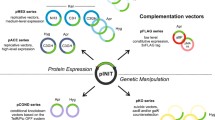Abstract
Mycobacterium tuberculosis H37Ra,M. smegmatisATCC 607,M. smegmatis MC2155,M. aurum A +,M. aurum A11, and one representative strain ofM. flavescens were transformed by electroporation with plasmid pMY10 and cosmid pDC100. Plasmid pMY 10 contained the origin of replication of pAL5000, the origin of replication of pBR322, a kanamycin resistance gene, and the origin of transfer of the Inc plasmid RK2; the cosmid pDC100 contained the pHC79 SS cosmid, the origin of replication of pAL5000, and a kanamycin resistance gene. The efficiency of transformation varied with the recipient cells used and was in decreasing order: 7×105 forM. smegmatis MC2155, 6×103 forM. tuberculosis H37Ra, 103 forM. aurum, 50 forM. smegmatis ATCC 607, and 5 forM. flavescens. A rapid protocol for plasmid extraction from mycobacteria was developed.
The satisfactory transformation of the nonvirulentM. tuberculosis strain H37Ra was of interest for future studies on cloning of virulence genes, while the satisfactory transformation ofM. aurum was of interest for future studies on the genetics of drug resistance because these bacteria are sensitive to drugs specifically used in the treatment of tuberculosis and leprosy. However, neither vector was stably maintained inM. smegmatis, indicating that further investigations are still necessary to resolve this difficulty.
Similar content being viewed by others
Literature Cited
Boyer HW, Roulland-Dussoix D (1969) A complementation analysis of the restriction and modification of DNA inE coli J Mol Biol 41:459–472
David HL, Clavel S, Clément F, Moniz-Pereira J (1980) Effects of antituberculosis and antileprosy drugs on mycobacteriophage D29 growth. Antimicrob Agents Chemother 18:357–359
Figurski DH, Helinski D (1979) Replication of an origin-containing derivative of plasmid RK2 dependent on a plasmid function provided in trans. Proc Natl Acad Sci USA 76:1648–1652
Gicquel-Sanzey B, Moniz-Pereira J, Gheorghiu M (1989) Structure of pAL5000, a plasmid fromM. fortuitum and its utilization in transformation of mycobacteria, Acta Leprol 7 (suppl 1):208–211
Guiney DG, Yakobson E (1983) Location and nucleotide sequence of the transfer origin of the broad host range plasmid RK2. Proc Natl Acad Sci USA 80:3595–3598
Hohn B, Collins J (1980) A small cosmid for efficient cloning of large DNA fragments. Gene 11:291–298
Jacobs Jr WR, Tuckman M, Bloom BR (1987) Introduction of foreign DNA into mycobacteria using a shuttle phasmid. Nature 327:532–534
Labidi A, Dauguet C, Goh KS, David HL (1984) Plasmid profiles ofMycobacterium fortuitum complex isolates. Curr Microbiol 11:235–240
Labidi A, David HL, Roulland-Dussoix D (1985) Cloning and expression of mycobacterial plasmid DNA inEscherichia coli. FEMS Microbiol Lett 30:221–225
Labidi A, David HL, Roulland-Dussoix D (1985) Restriction endonulcease mapping and cloning ofMycobacterium fortuitum var.fortuitum plasmid pAL5000. Ann Inst Pasteur Microbiol 136B:209–215
Labigne-Roussel A, Harel J Tompkins LS (1987) Gene transfer fromEscherichia coli to Campylobacter species. Development of shuttle vectors for genetic analysis ofCampylobacter jejuni. J Bacteriol 169:5320–5323
Lazraq R, Moniz-Pereira J, Clavel-Sérès S, Clément F, David HL (1989) Restriction map of mycobacteriophage D29 and its deletion mutant F5. Acta Leprol 7 (Suppl 1):234–238
Lazraq R, Clavel-Sérès S, David HL, Roulland-Dussoix D (1990) Conjugative transfer of a shuttle plasmid fromEscherichia coli toMycobacterium smegmatis. FEMS Microbiol Lett 69:135–138
Lévy-Frébault V, David HL (1979) Mutations affecting pigment synthesis inMycobacterium aurum. J Gen Microbiol 115:317–323
Lugosi L, Jacobs Jr WR, Bloom BR (1989) Genetic transformation of BCG. Tubercle 70:159–170
Maniatis T, Fritsch EF, Sambrook J (1982) Molecular cloning: a laboratory manual, Cold Spring Harbor, NY.: Cold Spring Harbor Laboratory, pp 86–94
Perbal B (1988) A practical guide to molecular cloning, second edn. John Wiley and Sons, pp 424–452
Rastogi N, David HL (1981) Ultrastructural and chemical studies on wall-deficient forms, spheroplasts and membrane vesicles fromMycobacterium aurum. J Gen Microbiol 124:71–79
Rastogi N, David HL (1988) Mechanisms of pathogenicity in mycobacteria. Biochimie 70:1101–1120
Rauzier J, Moniz-Pereira J, Gicquel-Sanzey B (1988) Complete nucleotide sequence of pAL5000, a plasmid fromMycobacterium fortuitum. Gene 71:315–321
Redmond WB, Ward DM (1966) Media and methods for phage-typing mycobacteria. Bull. WHO 35:563–568
Snapper SB, Lugosi L, Jekkel A, Melton RE, Kieser T, Bloom BR, Jacobs Jr WR (1988) Lysogeny and transformation in mycobacteria: stable expression of foreign genes. Proc Natl Acad Sci USA 85:6987–6991
Southern E (1975) Detection of specific sequences among DNA fragments separated by gel electrophoresis. J Mol Biol 98:503–514
Trieu-Cuot P, Gerbaud G, Lambert T, Courvalin P (1985) In vivo transfer of genetic information between Gram-positive and Gram-negative bacteria. EMBO J 4:3583–3587
Trieu-Cuot P, Carlier C, Martin P, Courvalin, P (1987) Plasmid transfer by conjugation fromEscherichia coli to Grampositive bacteria. FEMS Microbiol Lett 48:289–294
Zainuddin ZF, Kunze ZM, Dale JW (1989) Transformation ofMycobacterium smegmatis withEscherichia coli plasmids carrying a selectable resistance marker. Mol Microbiol 3:29–34
Author information
Authors and Affiliations
Rights and permissions
About this article
Cite this article
Lazraq, R., Clavel-Sérès, S. & David, H.L. Transformation of distinct mycobacterial species by shuttle vectors derived from theMycobacterium fortuitum pAL5000 plasmid. Current Microbiology 22, 9–13 (1991). https://doi.org/10.1007/BF02106206
Issue Date:
DOI: https://doi.org/10.1007/BF02106206




